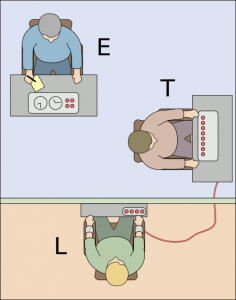By Briana Pocratsky
Dear Sociologist,
Using the Milgram experiment, can you analyze group members’ compliance to authority?
Sincerely,
Concerned about Compliance*
Dear Concerned about Compliance,
While Stanley Milgram’s experiments do not definitively explain all of the complexities of obedience to authority, especially in a group setting, his research does offer insight into how power dynamics may influence a person’s actions. Milgram, a social psychologist, discovered that the presence of an authority figure could, in some cases, cause individuals to act in contrast to their own morals. To get a better understanding of how authority can influence people’s actions, it is important to take a closer look at the different variations and conclusions of Milgram’s obedience experiments.
In his article “Behavioral Study of Obedience,” Milgram (1963) asserts that obedience is a “ubiquitous and indispensable feature of social life” and the “dispositional cement that binds” people “to systems of authority” (pp. 371-72). Milgram explains that the study of obedience is crucial:
Obedience…is of particular relevance to our time. It has been reliably established that from 1933-45 millions of innocent persons were systematically slaughtered on command. Gas chambers were built, death camps were guarded, daily quotas of corpses were produced with the same efficiency as the manufacturer of appliances. These inhumane policies may have originated in the mind of a single person, but they could only be carried out on a massive scale if a very large number of persons obeyed orders (p. 371).
In order to better understand why individuals and large groups of people would commit such atrocities, Milgram, while an assistant professor at Yale University, completed a series of experiments. He explored the conditions of (dis)obedience; he questioned to what extent would a participant in a study comply with orders from an experimenter to hurt another individual, even if the instructions may conflict with the participant’s morality? Under what conditions will the participant not carry out the orders and disobey authority?
Milgram’s Obedience Studies
Milgram conducted a series of experiments to better understand the conditions of obedience (Milgram 1963, 1965, 1974). In his first publication on the series, his experiment included 40 male participants between the ages of 20-50 years old with differing educational and occupational backgrounds who resided in the New Haven area and who were recruited for a study of “memory and learning at Yale University” (1963: 372).
This experiment consisted of the following procedures: When the participant arrived to the laboratory for the study, the experimenter, a white male in a gray lab coat, informed the participant and an actor, who appeared to be a participant, that they were taking part in a memory study that focused on punishment and learning (a topic that lacked scientific research). The experimenter explained that one participant would act as the “teacher” and the other as the “learner” for the exercise. The experimenter instructed both the participant and the actor to a draw a slip of paper from a rigged drawing whereby the participant was always the teacher and the actor was always the learner. The teacher watched as the learner was “strapped into an ‘electric chair’ apparatus” (that administered shocks on the learner’s wrist) (p. 373). The experimenter stated that the shocks can be “extremely painful” but will cause “no permanent tissue damage” (ibid.).
The teacher would read a list of word pairs to the learner from the adjoining room. In this room, the teacher had access to a shock generator, which appeared to be connected to the learner’s wrist. The teacher would read the first word from the pair, and the learner was expected to recall the second word in the pair. If the learner answered correctly, they moved on to the next word pair. If the learner answered incorrectly, the teacher would shock the learner. The experimenter instructed the teacher to administer incrementally more severe shocks using lever switches if the learner answered incorrectly. The simulated shock generator used “30 clearly marked voltage levels that range[d] from 15 to 450 volts” with coinciding “verbal designations that range[d] from Slight Shock to Danger: Severe Shock” to “XXX” (p. 372). While the situation was constructed to seem authentic to the participant-teacher, the actor-learner did not receive any shocks.
According to Milgram, the experiment was standardized, and the responses of the learner and the experimenter were standardized as well. For example, in this variation of the study, if the participant administered a 300 volt shock, the learner acted as if they were in pain by kicking the wall and no longer provided answers to the teacher. The pounding occurred again at the 315 volt shock, and the learner provided no further responses.
In another condition,1 the verbal responses of the learner were taped, and “each protest [was] coordinated to a particular voltage level on the shock generator” in which at 75 volts the learner “beg[an] to grunt and moan,” at 150 volts the learner demanded to quit the experiment, at 180 volts “he crie[d] out that he can no longer stand the pain” and at 300 volts “he refuse[d] to provide any more answers to the memory test, insisting that he [was] no longer a participant” and must be let out (Milgram 1965: 60).
When the participant-teacher exhibited an unwillingness to continue with the experiment, the experimenter responded with a sequence of prods such as “[t]he experiment requires that you continue” (Milgram 1963: 374).
Results
In the variation of the study detailed above, “[n]o subject stopped prior to administering Shock Level 20,” or 300 volts, and “[o]f the 40 subjects, 26 obeyed the orders of the experimenter to the end, proceeding to punish the victim until they reached the most potent shock available on the shock generator” (Milgram 1963: 375-76). In this case, and in other variations of the study, many participants exhibited what Milgram (1963: 375) termed “signs of extreme tension” in which they would “sweat, tremble, stutter, bite their lips, groan, and dig their fingernails into their flesh” in addition to having nervous laughing fits. A few participants even had seizures. Milgram reflects on the general findings of the experiments in the following quote:
“[The results] raise the possibility that human nature, or -more specifically- the kind of character produced in American democratic society, cannot be counted on to insulate its citizens from brutality and inhumane treatment at the direction of malevolent authority. A substantial proportion of people do what they are told to do, irrespective of the content of the act and without limitations of conscience, so long as they perceive that the command comes from a legitimate authority” (Milgram 1965: 75).
As part of the series, Milgram also considered (dis)obedience in relationship to group situations. For example, in one study, Milgram had three teachers in the room with the simulated shock generator. Two of them were actors and one of them was a participant. When the actors quit in the middle of the learning exercise, “90 per cent of the subjects followed suit and defied the experimenter” (p. 71). In another variation, an actor administered the shocks to the learner as the participant observed.
With this variation, only three participants out of forty defied the experimenter. In yet another condition, the participant and actors were tasked with deciding the shock level they would use to punish the learner for a wrong answer. Actors recommended increasingly higher shock levels. Some participants challenged the increase in shock levels while others went along with the actors.
Replications and Alternative Interpretations
Variations of Milgram’s obedience experiments have been replicated. For example, Jerry Burger (2009) partially replicated one of Milgram’s studies with similar findings. In Burger’s (2009) base condition, “[t]he percentage of participants who continued the procedure after pressing the 150-volt switch was examined,” and “70% of the base condition participants continued with the next item on the test and had to be stopped by the experimenter” (compared to Milgram’s 82.5% of participants) (p. 8).
In another variation of Burger’s study, called the “modeled refusal condition,” two actors (one teacher and one learner) and a participant were involved in the experiment. In this situation, the actor-teacher administers the shocks and stops after pressing the 90 volt switch. The participant is then asked to take-over and administer the shocks because the actor-teacher refuses to continue. In most cases, the participant continued with the shocks past the 150 volt point (63.3%).
In addition to their popularity, Milgram’s obedience experiments unsurprisingly have a number of ethical and methodological concerns, making it a “contentious classic” (Tavris 2014).Milgram’s experiments have been criticized recently for misrepresentations of the debriefing process (some participants were not fully debriefed), the experimenter’s off-script improvisation of prods, and Milgram’s selective reporting of results. Richard A. Griggs (2017) explains that some social psychologists have reinterpreted Milgram’s findings. Essentially, “this reinterpretation argues that the experiments were not about obedience to authority but rather engaged followership based on identification with the experimenter and his scientific project” (p. 33).2
Are the Obedience Studies Still Relevant?
As the merit of Milgram’s obedience studies is continually revisited and questioned, and reinterpretations of his findings evolve, it will be interesting to see how Milgram’s experiments are framed and taught in the future. However, larger questions regarding the construction, operation, and maintenance of authority (and individual choice and resistance) in society remain pertinent.
What are authority’s forms, signifiers, and spaces of operation, and how is its power individually and systemically implemented?3 Whether in a lab coat, military uniform, or cassock, Milgram’s studies, at the very least, remind us that we should be ever vigilant in the presence of authority: what it looks like, the power it wields, and how this power may be used to harm groups of people in society.
Additional Resources
Asch conformity experiments; Stanford Prison Experiment: Studies related to the obedience experiments ▪ Eichmann in Jerusalem: A Report on the Banality of Evil (1963): A book by political theorist Hannah Arendt concerning the trial of Nazi leader Adolf Eichmann ▪ Obedience (1965): Stanley Milgram’s documentary film on the obedience experiments ▪ Experimenter (2015): An entertainment film about Stanley Milgram and the obedience studies ▪ Shock Room (2015): A documentary film about Stanley Milgram’s obedience studies.
*Question was edited for clarity.
References
Burger, Jerry M. 2009. “Replicating Milgram.” American Psychologist 64(1):1–11.
Griggs, Richard A. 2017. “Milgram’s Obedience Study: A Contentious Classic Reinterpreted.” Teaching of Psychology 44(1):32–37.
Milgram, Stanley. 1963. “Behavioral Study of Obedience.” Journal of Abnormal and Social Psychology 67(4):371–78.
Milgram, Stanley. 1965. “Some Conditions of Obedience and Disobedience to Authority.” Human Relations 18:57–76.
Milgram, Stanley. 1974. Obedience to Authority: An Experimental View. New York: Harper & Row.
Tavris, Carol A. 2014. “Teaching Contentious Classics.” APS Observer 27(8).
Weber, Max. [1925] 2008. “The Types of Legitimate Domination.” Pp. 178–84 in Classical and Contemporary Sociological Theory. Los Angeles, CA: Pine Forge Press.
Notes
- Some other variations in the series of experiments include the participant’s proximity to the learner, the participant’s closeness to authority, the setting of the laboratory experiment, and the gender of participants. In an unreported experiment, pairs of participants who knew one another in some capacity were included in a condition. One participant was the teacher and the other participant was the learner (see Griggs 2017). The different conditions in the experiments had varying results.
- For an overview of old and new criticisms and reinterpretations of the obedience studies’ findings, please see Griggs (2017).
- Sociologist Max Weber ([1925] 2008) considered forms of domination that bring about the belief of legitimacy, or authority in society. Weber classifies “the types of domination according to the kind of claim to legitimacy typically made by each” and its relationship to obedience (p.179). Weber states that legitimate domination in society generally adheres to three ideal types or pure forms: traditional authority, charismatic authority, and rational-legal authority.


